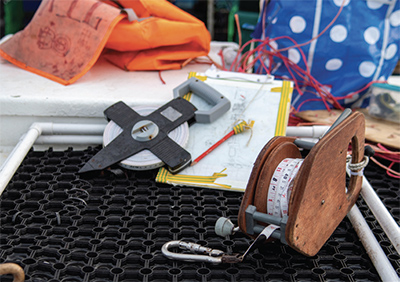
Jane Maddocks shares some useful hacks for project divers working to a budget.
It’s all too easy to talk glibly about survey methods underwater. It might be worth sharing some of my hacks to help make your diving project even more successful. These methods work for marine critter surveys, and wreck surveys, so are worth thinking about.
So, let’s talk tapes.
Tapes are expendable. For a few pounds you can get accurate measurements. A surveyor’s tape about 30m long will do for most surveys. I always attach a short piece of line on the end, so I can secure it to the shot. I would tie it on – but underwater knots can be difficult to undo, so use a clip of karabiner. At the handle end, I may have a weight attached. On a soft bottom, I use tent pegs from the local camping store. Once the tape is locked off, I can start my survey.
Over time the handle drops off. This is okay for reeling out, but hopeless for reeling in or even locking off. But it’s cheap to buy, so no problem. However, if you have friends who are upgrading their larger DSMB reels, you can transfer the tape to the DSMB reel and have something that reels out nicely, is lockable, and easy to reel back in.
These methods work for marine critter surveys, and wreck surveys, so are worth thinking about
Measurements need to be recorded. I use an A4 board, with a clip to attach it to me and TWO pencils – B is the best hardness for underwater use. Seasearch produces a really nice A4 board, and dive companies have boards or slates on offer.
So, board, clip, two pencils. Once you surface, take a photo on your phone. For a permanent record, use drafting film (also known as Permatrace). It is a sturdier, waterproof alternative to tracing paper and ideally suited to layout drawings. Pencils draw onto it easily and the results do not fade fast: I still have underwater survey notes from 2009 in perfect condition in my archive.
 The hack here is to use A4 drawing film on your A4 slate/board, using electrical tape to secure all four sides.
The hack here is to use A4 drawing film on your A4 slate/board, using electrical tape to secure all four sides.
If your project has a proforma, for example the outline of the reef, you can print the outline onto to your film using a LaserJet printer. It won’t rub off, and you can work on your film as you dive. This is really useful for data collection forms, when you are all observing the same thing in different places.
Water-soluble intelligence is an issue for all of us; sometimes it’s hard to concentrate underwater! To stop yourself forgetting just what you’re meant to be doing down there, write it on your slate! Some of your brain function diverts to the part that wants to keep you alive. Writing your task on the board keeps you on track.
A survey often involves quadrats. These are fun to use, expensive to buy, and great to make. If you know anyone who can bend steel rod, then a three-sided ‘not quite’ quadrat is really useful, because you can set it against the tape.
Plastic piping, pipe corners, a power drill and some robust string can create a 1m gridded quadrat. Be sure to raid the drawer where you have the remnants of your old shot weight belt to put some lead into the piping to keep the thing down.
If you are putting your frame over a piece of wreck structure or doing a maerl count, then no gridding strings are necessary. If distribution within the frame is important you will need to put 10cm strings in. You may want to out a scale into you images. 1m of plastic pipe and a roll of black or red electrical tape will work.
Put 10cm of the black or red tape at each end, and in the middle to create a 1m scale showing 10cm divisions. Block off both ends after sliding some shot in. Drill a hole at the top for a shackle. You now have a 1m scale.
If DIY isn’t your thing, and there is no-one in the branch who wants to do it, look up the archaeology supplies businesses to buy drawing film, special pegs for holding tapes, and other useful tools. Then go out, experiment with how to use it all and enjoy getting good data for your projects.
Article ‘Helpful hacks for survey success’ by Jane Maddocks first published in SCUBA magazine, Issue 144 April 2024.

 Author: Jane Maddocks | Posted 06 May 2024
Author: Jane Maddocks | Posted 06 May 2024



